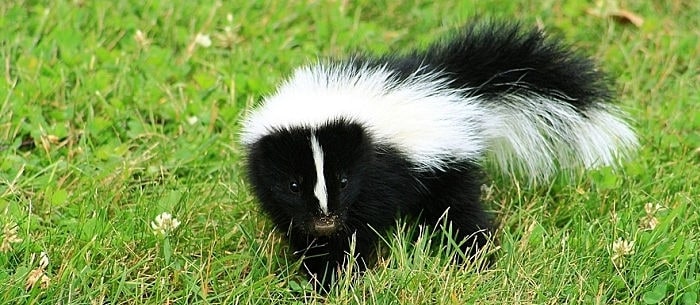Even if you’re the most careful of pet parents or caregivers, there’s still a risk that your dog will one day encounter a skunk. And this can lead to a stinky situation. Thankfully, this problem can be remedied through a few easy steps. Here’s everything you need to know about skunk encounters and how to get rid of skunk smell on dog fur.
Why Does a Skunk’s Spray Stink?
A skunk’s two main forms of defense are his bite and his spray, so this animal will often spray any potential predators that he finds to be threatening, which may include your dog. A skunk’s spray is made up of several chemicals that are pungent and offensive to the human nose — the key ingredient of which is sulfur.
These chemicals allow the spray to travel through the air very quickly, which means that even the faintest trace can linger for a long time. To make matters worse, the chemical makeup of a skunk’s spray makes it cling to fur and skin. As a result, it’s quite difficult to get rid of the smell.
How Can You Prevent Skunk Encounters?
If your dog has ever had an encounter with a skunk, you probably want to do everything in your power to avoid the situation again. But preventing these encounters is less about keeping your dog away from skunks and more about keeping the skunks away from your dog, says Laura Simon, a wildlife ecologist for the Humane Society of the United States.
According to Simon, it’s important to keep your dog from roaming free, especially during the night. This can prevent him from getting into trouble. And you should be particularly careful during skunk mating season in February, she says.
Another preventive measure you can take is to make sure that your yard is clean of plant debris and overgrown trees and bushes. Skunks and other critters like to hide in these types of places. Last, you can distribute skunk repellent or cat litter throughout your yard. Both of these products can serve to repel the pesky varmints. And be sure to keep your dog up-to-date on all of his shots. The rabies vaccination will protect him in the case that he gets bitten by an offending skunk.
What Should You Do if Your Dog Does Get Sprayed?
No matter how hard you try to protect your dog from skunks, he may be at risk of a smelly attack. Thankfully, though the smell may be so strong that you think it will never come out, there are some easy steps you can take to get your pet back to smelling like his old self again.
Here’s a step-by-step guide on how to get rid of skunk smell on dog fur:
- Keep Your Pet Outside
If you find out that your dog has been sprayed, you should not let him back inside the house until you have treated his fur.
- Wash Out His Eyes
“If you notice that your dog has been sprayed in the face, you’ll want to flush his eyes out with plain saline contact lens solution to prevent further irritation,” says Dr. Lori Pasternak, a veterinarian at Helping Hands Affordable Veterinary Surgery & Dental Care in Richmond, Virginia.
- Mix a De-Skunking Solution
There’s really no need to buy an expensive over-the-counter de-skunking solution. Instead, Dr. Pasternak recommends that you create your own solution by combining 1 quart of hydrogen peroxide, 1/4 cup of baking soda and 1 teaspoon of degreasing dish soap. She says she likes this recipe the best because it is inexpensive and very effective. Whatever you do, be sure to avoid trying the old tomato juice trick on your dog. That particular solution only works for humans.
- Bathe Your Pet With the Solution
After you have created your de-skunking solution, you should use it immediately, says Dr. Pasternak. Don’t rinse your pet with water first or it will dilute the efficacy. If possible, you should bathe your pet outside. Once you’re all set up, apply the solution and wash your dog vigorously.Afterward, let the solution sit on your dog’s fur for a full five minutes before rinsing him off with water. If you don’t feel that this process was as effective as you would have liked it to be, you can repeat as necessary. But “be sure to wear rubber gloves and old clothing that you can throw away if needed,” says Dr. Pasternak. This is a crucial step to ensuring that the skunk smell doesn’t get onto you.
How Can You Calm Your Dog After a Skunk Attack?
If your dog is agitated from being sprayed, you should try to let him calm down on his own first. But if he still seems to be upset, you can try to soothe him by offering him one of his favorite treats or putting him on a leash so that you can contain his erratic movements. Another great way to comfort your dog is to gently hold him down as he lies on his side, petting him throughout the process.
Unfortunately, this may cause you to get skunk smell on yourself and your clothes. Use your best judgment to determine if this type of comforting is necessary.
No matter how you choose to soothe your frightened dog, it’s important for you to be careful when approaching him. As your furry friend has just been through a scary situation, it’s possible that he may bite, even if he doesn’t normally engage in this type of aggressive behavior.
Wondering whether you should be washing your dog more regularly? Read How Often Should I Bathe My Dog?
Christina Montoya Fiedler is a Los Angeles-based freelance writer. She lives with her husband, two human kids, fur baby and feather baby.





